Fire Safety First: Demystifying Fire-Rated MDF (and Why Class A Matters)
Imagine this: you’re building your dream home, meticulously choosing materials that are both stylish and safe. You come across some amazing fire-retardant MDF (Medium-Density Fiberboard) for your built-in bookshelves – sleek, sturdy, and supposedly fire-resistant. But a nagging question pops into your head: is fire-retardant MDF actually fire-rated?
This guide will untangle the world of fire-rated MDF, explain the importance of Class A ratings, and help you choose the right material for a safe and stylish space.


Fire-Retardant vs. Fire-Rated MDF: Understanding the Difference
Let’s break it down. Fire-retardant MDF simply means the material has been treated with chemicals to slow down the spread of flames. This can be helpful for delaying a fire’s progress, but it doesn’t guarantee complete fire resistance.
Here’s where fire ratings come in. These ratings, established by organizations like ASTM International (American Society for Testing and Materials), classify building materials based on their performance in a controlled fire test. They tell you how long a material can withstand fire exposure before igniting or collapsing.
Now, the magic word: Class A. This is the holy grail of fire ratings for building materials in most residential applications (check your local building codes for specific requirements). Class A materials, including some fire-retardant MDF varieties, have the highest fire resistance rating, meaning they can withstand a fire for an extended period, giving occupants precious time to evacuate.
Here’s an analogy: Imagine fire-retardant MDF as a fire hose – it can slow down the flames, but it might not completely extinguish them. Class A fire-rated MDF, on the other hand, is like a fireproof door – it provides a significant barrier against the fire for a longer duration.
The Benefits of Class A Fire-Rated MDF: Safety Takes Center Stage
So, why should you care about Class A fire ratings when choosing fire-retardant MDF? Here are some compelling reasons:
Enhanced Safety: In a fire emergency, every second counts. Class A fire-rated MDF can buy valuable time for you and your family to escape safely. It can also help slow the spread of fire within the building, potentially minimizing damage.
Peace of Mind: Knowing your home is built with materials that prioritize safety can provide immense peace of mind. Class A fire-rated MDF allows you to sleep soundly at night, knowing you’ve taken an extra step toward fire safety.
Code Compliance: Many building codes mandate the use of Class A fire-rated materials in specific areas of a home, like hallways, stairwells, and utility rooms. Choosing Class A MDF ensures your project adheres to safety regulations.
Identifying Class A Fire-Rated MDF: Look for the Label
Now that you understand the importance of Class A ratings, how do you identify fire-rated MDF when shopping? Here’s what to look for:
Manufacturer Label: Reputable MDF manufacturers will clearly indicate the fire rating on the product label. Look for labels mentioning “Class A Flame Spread Rating” or similar terms.
Certification Mark: Some MDF might carry a certification mark from a recognized fire testing organization like UL (Underwriters Laboratories) or FM Approvals. These marks provide additional assurance of the material’s fire resistance.
Ask the Experts: If you’re unsure about a specific MDF product, don’t hesitate to ask the staff at your local building supply store. They can help you decipher labels and recommend Class A fire-rated MDF options.
Remember: When it comes to fire safety, it’s always better to be safe than sorry. Opting for Class A fire-rated MDF might cost slightly more, but the peace of mind and enhanced safety it offers are priceless.
Beyond Class A: Additional Considerations for Fire Safety
While Class A fire-rated MDF is a fantastic choice, here are some additional tips to maximize fire safety in your home:
Fire Alarms & Detectors: Install smoke detectors and fire alarms throughout your home and ensure they’re regularly tested and maintained.
Fire Escape Plan: Develop and practice a fire escape plan with your family, ensuring everyone knows the designated exits and meeting points.
Fire Extinguishers: Having readily accessible fire extinguishers in key locations can be crucial in containing a small fire before it escalates.
By making informed choices about fire-rated materials like Class A MDF and implementing additional safety measures, you can create a beautiful and, more importantly, safe haven for yourself and your loved ones.
Post time: 05-28-2024











